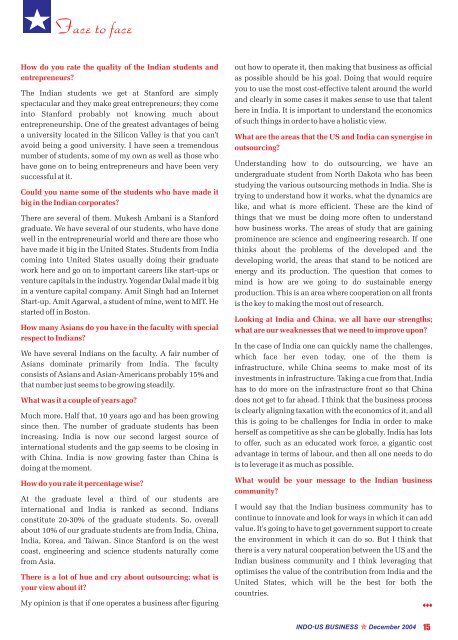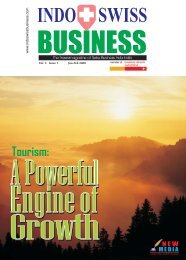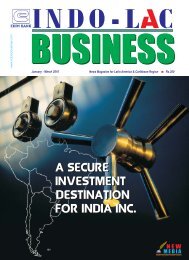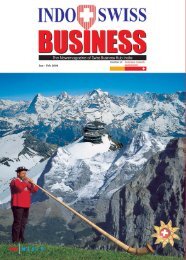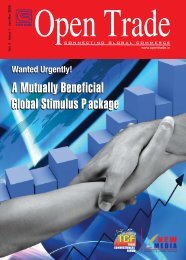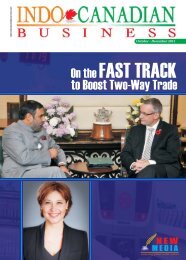Indo-US Partnership - new media
Indo-US Partnership - new media
Indo-US Partnership - new media
You also want an ePaper? Increase the reach of your titles
YUMPU automatically turns print PDFs into web optimized ePapers that Google loves.
Face to face<br />
How do you rate the quality of the Indian students and<br />
entrepreneurs?<br />
The Indian students we get at Stanford are simply<br />
spectacular and they make great entrepreneurs; they come<br />
into Stanford probably not knowing much about<br />
entrepreneurship. One of the greatest advantages of being<br />
a university located in the Silicon Valley is that you can't<br />
avoid being a good university. I have seen a tremendous<br />
number of students, some of my own as well as those who<br />
have gone on to being entrepreneurs and have been very<br />
successful at it.<br />
Could you name some of the students who have made it<br />
big in the Indian corporates?<br />
There are several of them. Mukesh Ambani is a Stanford<br />
graduate. We have several of our students, who have done<br />
well in the entrepreneurial world and there are those who<br />
have made it big in the United States. Students from India<br />
coming into United States usually doing their graduate<br />
work here and go on to important careers like start-ups or<br />
venture capitals in the industry. Yogendar Dalal made it big<br />
in a venture capital company. Amit Singh had an Internet<br />
Start-up. Amit Agarwal, a student of mine, went to MIT. He<br />
started off in Boston.<br />
How many Asians do you have in the faculty with special<br />
respect to Indians?<br />
We have several Indians on the faculty. A fair number of<br />
Asians dominate primarily from India. The faculty<br />
consists of Asians and Asian-Americans probably 15% and<br />
that number just seems to be growing steadily.<br />
What was it a couple of years ago?<br />
Much more. Half that, 10 years ago and has been growing<br />
since then. The number of graduate students has been<br />
increasing. India is now our second largest source of<br />
international students and the gap seems to be closing in<br />
with China. India is now growing faster than China is<br />
doing at the moment.<br />
How do you rate it percentage wise?<br />
At the graduate level a third of our students are<br />
international and India is ranked as second. Indians<br />
constitute 20-30% of the graduate students. So, overall<br />
about 10% of our graduate students are from India, China,<br />
India, Korea, and Taiwan. Since Stanford is on the west<br />
coast, engineering and science students naturally come<br />
from Asia.<br />
There is a lot of hue and cry about outsourcing; what is<br />
your view about it?<br />
My opinion is that if one operates a business after figuring<br />
out how to operate it, then making that business as official<br />
as possible should be his goal. Doing that would require<br />
you to use the most cost-effective talent around the world<br />
and clearly in some cases it makes sense to use that talent<br />
here in India. It is important to understand the economics<br />
of such things in order to have a holistic view.<br />
What are the areas that the <strong>US</strong> and India can synergise in<br />
outsourcing?<br />
Understanding how to do outsourcing, we have an<br />
undergraduate student from North Dakota who has been<br />
studying the various outsourcing methods in India. She is<br />
trying to understand how it works, what the dynamics are<br />
like, and what is more efficient. These are the kind of<br />
things that we must be doing more often to understand<br />
how business works. The areas of study that are gaining<br />
prominence are science and engineering research. If one<br />
thinks about the problems of the developed and the<br />
developing world, the areas that stand to be noticed are<br />
energy and its production. The question that comes to<br />
mind is how are we going to do sustainable energy<br />
production. This is an area where cooperation on all fronts<br />
is the key to making the most out of research.<br />
Looking at India and China, we all have our strengths;<br />
what are our weaknesses that we need to improve upon?<br />
In the case of India one can quickly name the challenges,<br />
which face her even today, one of the them is<br />
infrastructure, while China seems to make most of its<br />
investments in infrastructure. Taking a cue from that, India<br />
has to do more on the infrastructure front so that China<br />
does not get to far ahead. I think that the business process<br />
is clearly aligning taxation with the economics of it, and all<br />
this is going to be challenges for India in order to make<br />
herself as competitive as she can be globally. India has lots<br />
to offer, such as an educated work force, a gigantic cost<br />
advantage in terms of labour, and then all one needs to do<br />
is to leverage it as much as possible.<br />
What would be your message to the Indian business<br />
community?<br />
I would say that the Indian business community has to<br />
continue to innovate and look for ways in which it can add<br />
value. It's going to have to get government support to create<br />
the environment in which it can do so. But I think that<br />
there is a very natural cooperation between the <strong>US</strong> and the<br />
Indian business community and I think leveraging that<br />
optimises the value of the contribution from India and the<br />
United States, which will be the best for both the<br />
countries.<br />
<br />
INDO-<strong>US</strong> B<strong>US</strong>INESS December 2004<br />
15


